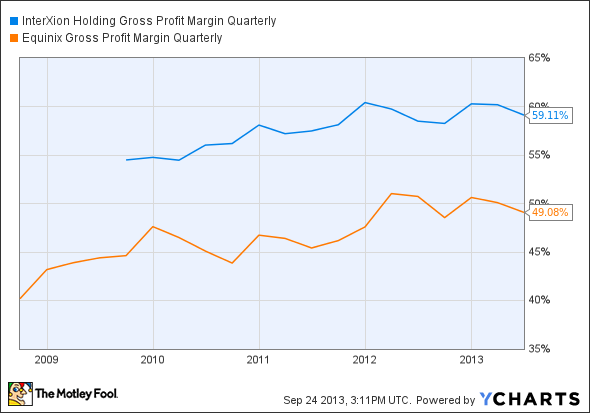Those of you old enough to be investing before the
year 2000 will recall that there there was another recession in the last
decade or so. Many investors have forgotten about the technology boom
and bust that occurred at the start of the last decade. However, in
certain sectors like telecommunications and Internet infrastructure, the
scars still run deep. Indeed, stock prices of data center providers
like Equinix (NASDAQ: EQIX ) , InterXion (NYSE: INXN ) , and the U.K.'s Telecity
are all down in 2013, largely because of fears of the sort of
overcapacity that plagued the economy after the tech bust. Are the
concerns justified? Is now a time to buy?
As is always the case in investing, the answer is yes, and also no.
Why it's a "no"
Economics 101 will tell you that most industries follow a pretty familiar path. High profits in an industry tend to encourage new entrants (or in this case, encourage existing providers to invest in new data centers), and capacity increases as everyone enjoys profits. After the initial profit euphoria, history tells us that firms tend to over-invest, only to then see profitability fall as too much supply is on tap. Indeed, all the leading players have been aggressively expanding data center capacity in recent years.
Of course, the problem for investors comes when
profitability starts to fall in anticipation of tougher conditions.
Analysts start downgrading their price targets, and suddenly the roof
caves in on your stock. Everyone then realizes that end-demand was
vastly overestimated. All of this happened in 2000 with Internet
infrastructure darlings like Cisco Systems (NASDAQ: CSCO ) and Alcatel-Lucent. The fallout was painful.

Fast-forward to today and there are signs that the
data-center providers may be facing overcapacity issues. The single best
indicator is probably gross margin. Decline is an indication of a drop
in pricing power, while an increase represents the contrary.

Gross margins look like they are moderating for InterXion and Equinix. Furthermore, Telecity
saw its gross margin decline in the first half from 57.3% last year to
56.9% this year. Telecity's revenue per occupied square meter increased
only 2.1%, which suggests that future revenue increases will come from
capacity expansion rather than pricing.
Turning to Equinix, it reduced its forecast for
second-half revenue growth, partly because it saw softer conditions in
Germany, longer sales cycles within its enterprise markets, and its
average deal size appears to be getting smaller. All three are signs of
slower growth.
InterXion gave results in August, stating:
Customers continue to have extended decision-making time frames, but demand remains healthy and the pricing environment is consistent with previous quarters, as is the sales pipeline.
Again, when sales cycles get longer, it is usually a
sign of a slowing market. If pricing is consistent, it implies the
industry players are finding it harder to increase them.
Why it's a "yes"
This isn't the late 90s. It really is different this time around because long-term demand looks much better-placed.
Internet-enabled devices -- smartphones, tablets,
etc. -- simply weren't available back then in order to drive demand for
all the network capacity that had been built up. It's a different story
now. AT&T and Verizon are both
seeing strong smartphone subscriber growth, and Intel has had to take
substantive action to change its business, thanks to the shift to mobile
devices.
It's a similar story with corporate demand for
cloud computing, and software as a service (SaaS) applications. All of
which is leading to demand for data centers to store information and
applications for corporation. Moreover, financial services firms are not
displaying any slowdown in their desire to use increasingly complex
trading systems.
Data center demand remains high as evidenced by Cisco's revenues.

source: company accounts
Where next for Equinix?
In conclusion, end demand does appear to be slowing, and analysts/investors are starting to downgrade expectations. However, this is arguably reflected in Equinix's share prices right now. The key valuation metric -- as defined by Equinix -- is the 'adjusted discretionary free cash-flow.' Roughly speaking, this is the free cash flow generated if you strip out the expansionary CapEx. In its last update, Equinix forecast this figure to be around $620 million to $640 million for 2013, which represents around 5.2% of its current enterprise value.
The valuation looks fair, but the stock carries the
normal risks inherent in industries that are facing short term risk. If
you are a cautiously minded investor, you might wait for a better entry
point to compensate for the risk that margins start to fall.
Alternatively, you could monitor gross margins, and industry pricing
power in order to gauge when the demand has caught up with capacity.
No comments:
Post a Comment